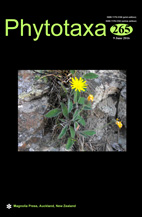Abstract
Two new brown-rot corticioid fungi, Dacryobolus gracilis and D. montanus, are described from Chongqing Municipality and Guangxi Autonomous Region, southwestern China. Dacryobolus gracilis is characterized by fragile, ceraceous basidiocarps, odontioid hymenophore with slender aculei, presence of long aculeal cystidia in the central part of the aculei and narrowly allantoid basidiospores; D. montanus is characterized by resupinate, ceraceous basidiocarps, odontioid hymenophore with thicker aculei, absence of cystidia or cystidioles, and narrowly allantoid basidiospores. Molecular phylogeny inferred from internal transcribed spacer (ITS) and ribosomal large subunit (nLSU) sequences data indicated that these two new species were clustered with the other species of Dacryobolus with a strong support. These two new species are described and illustrated in this paper. A key to known species of Dacryobolus is provided.

